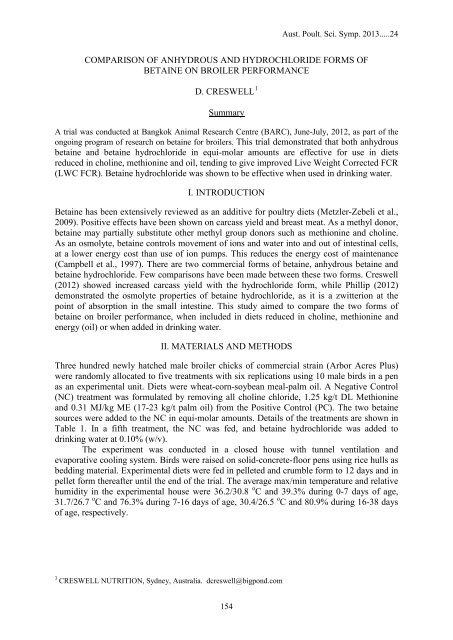APSS 2013 Proceedings - The University of Sydney
APSS 2013 Proceedings - The University of Sydney
APSS 2013 Proceedings - The University of Sydney
You also want an ePaper? Increase the reach of your titles
YUMPU automatically turns print PDFs into web optimized ePapers that Google loves.
Aust. Poult. Sci. Symp. <strong>2013</strong>.....24<br />
COMPARISON OF ANHYDROUS AND HYDROCHLORIDE FORMS OF<br />
BETAINE ON BROILER PERFORMANCE<br />
D. CRESWELL 1<br />
Summary<br />
A trial was conducted at Bangkok Animal Research Centre (BARC), June-July, 2012, as part <strong>of</strong> the<br />
ongoing program <strong>of</strong> research on betaine for broilers. This trial demonstrated that both anhydrous<br />
betaine and betaine hydrochloride in equi-molar amounts are effective for use in diets<br />
reduced in choline, methionine and oil, tending to give improved Live Weight Corrected FCR<br />
(LWC FCR). Betaine hydrochloride was shown to be effective when used in drinking water.<br />
I. INTRODUCTION<br />
Betaine has been extensively reviewed as an additive for poultry diets (Metzler-Zebeli et al.,<br />
2009). Positive effects have been shown on carcass yield and breast meat. As a methyl donor,<br />
betaine may partially substitute other methyl group donors such as methionine and choline.<br />
As an osmolyte, betaine controls movement <strong>of</strong> ions and water into and out <strong>of</strong> intestinal cells,<br />
at a lower energy cost than use <strong>of</strong> ion pumps. This reduces the energy cost <strong>of</strong> maintenance<br />
(Campbell et al., 1997). <strong>The</strong>re are two commercial forms <strong>of</strong> betaine, anhydrous betaine and<br />
betaine hydrochloride. Few comparisons have been made between these two forms. Creswell<br />
(2012) showed increased carcass yield with the hydrochloride form, while Phillip (2012)<br />
demonstrated the osmolyte properties <strong>of</strong> betaine hydrochloride, as it is a zwitterion at the<br />
point <strong>of</strong> absorption in the small intestine. This study aimed to compare the two forms <strong>of</strong><br />
betaine on broiler performance, when included in diets reduced in choline, methionine and<br />
energy (oil) or when added in drinking water.<br />
II. MATERIALS AND METHODS<br />
Three hundred newly hatched male broiler chicks <strong>of</strong> commercial strain (Arbor Acres Plus)<br />
were randomly allocated to five treatments with six replications using 10 male birds in a pen<br />
as an experimental unit. Diets were wheat-corn-soybean meal-palm oil. A Negative Control<br />
(NC) treatment was formulated by removing all choline chloride, 1.25 kg/t DL Methionine<br />
and 0.31 MJ/kg ME (17-23 kg/t palm oil) from the Positive Control (PC). <strong>The</strong> two betaine<br />
sources were added to the NC in equi-molar amounts. Details <strong>of</strong> the treatments are shown in<br />
Table 1. In a fifth treatment, the NC was fed, and betaine hydrochloride was added to<br />
drinking water at 0.10% (w/v).<br />
<strong>The</strong> experiment was conducted in a closed house with tunnel ventilation and<br />
evaporative cooling system. Birds were raised on solid-concrete-floor pens using rice hulls as<br />
bedding material. Experimental diets were fed in pelleted and crumble form to 12 days and in<br />
pellet form thereafter until the end <strong>of</strong> the trial. <strong>The</strong> average max/min temperature and relative<br />
humidity in the experimental house were 36.2/30.8 o C and 39.3% during 0-7 days <strong>of</strong> age,<br />
31.7/26.7 o C and 76.3% during 7-16 days <strong>of</strong> age, 30.4/26.5 o C and 80.9% during 16-38 days<br />
<strong>of</strong> age, respectively.<br />
1 CRESWELL NUTRITION, <strong>Sydney</strong>, Australia. dcreswell@bigpond.com<br />
154
















